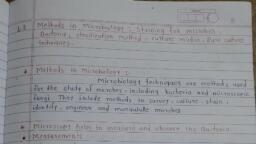Page 2 :
DATE, 2., characteristic features of :-, a) Phyto plasma :-, Phytoplasmas are obligate intra cellular, parasite of plant phloem tissue and of the insect vectors, that are involved in their plant - to-plant transmission., OR, Any of a group of extremely small bacteria that are, Similar to myCoplasmas., characteristics :-, Phytoplasmas were, who termed them mycoplasma - like- organisms'., phytoplasmas are bounded bya triple layered membrane, rather thana cell wall, Phytoplasmas are characterized by the 'lack of cel wall!, They have pleiomorphic oT filamentous shape-, A diameter normally less than 1 um ģ a vert s mall genome., discovered in 1967 by Japanese Scientist, plasmas are obligate intracellalar parasite of plant., They are transmitted from plant to plant by vectors, C normally by a sap - sucking insects such as leaf hoppers ),, in which they both survive and replicate., Phytoplasmas are pathogens of agriculturally important, plants including coconut, sugar cane and Sandal wood, in, which they cause a wide variety of svmptoms ranging, from mild yellowing to death., phytoplasmas can infect and cause various symptoms in, more than 700 plant species., one characteristic symptom is abnormal floral organ, development including phylloidy Ci es the production of leat, like structures in place of flowers., They ave most prevalent in tropical sub- tropical regions-, Phytoplasmas Tequires insect vectors $ cannot be cultured-, Phy
Page 3 :
barteria filam entous bacteria that form a branching network, common characteristics with fungi and cause similar disease, :-, 6) Actinomycetes, The actinomycetes are group of unicellular, filaments and produce Speres., OR., Actinomycetes are, a group of bacteria that share some, n fungi. They are able to form hyphae usually considered, a trait of fungi only., characteristics -, Actinomicetes belongs to group of Prokartotic gram positive, hasteria those are having filamentous structure., It is having Pilamentous structure resembles the fungal, mycelium, which consists of a highly dense and filamentous, network., Due to the Pilamentous structure actinomycetes termed as, thread bacteria'., The cell wall and the internal structure of actinomycetes, are similar to the group of bacleria., Thus they refer to the filamentous actinobacteria that serves, as a connecting link between the bactenia and fungi and, shows resemblance with both., Actinomycetes behave like decomposers which carry out, the degradation of organic compounds like chitin ,complex, sugars, hemicellulose etc., Actinomycetes usually have 1-2 um diameter., Most of the species are derobic while few are anaerobic, to facultative acrobes., The growth or reproduction of actinomycetes is slower than, the bacteria & fungi. Hence, they are some times called ae, Slow growers'.




















































